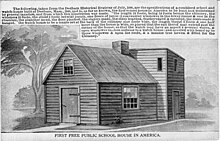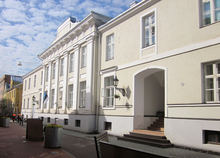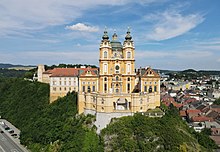Secondary school

A secondary school or high school is an institution that provides secondary education and also usually includes the building where this takes place. Some secondary schools provide both lower secondary education (ages 11 to 14) and upper secondary education (ages 14 to 18), i.e., both levels 2 and 3 of the ISCED scale, but these can also be provided in separate schools.
In the United States, most local secondary education systems have separate middle schools and high schools. In the UK, most state schools and privately funded schools accommodate pupils between the ages of 11–16 or 11–18; some UK private schools, i.e. public schools, admit pupils between the ages of 13 and 18.[1][2][3]
This section may be confusing or unclear to readers. (December 2023) |
Secondary schools follow on from primary schools and prepare for vocational or tertiary education. In high and middle income countries, attendance is usually compulsory for students at least until age 16. The organisations, buildings, and terminology are more or less unique in each country.[4][5]
Levels of education
In the ISCED 2011 education scale[6] levels 2 and 3 correspond to secondary education which are as follows:
- Lower secondary education
- First stage of secondary education building on primary education, typically with a more subject-oriented curriculum. Students are generally around 11–16 years old.[6]
- Upper secondary education
- Second stage of secondary education and final stage of formal education for students typically aged 16–18, preparing for tertiary/adult education or providing skills relevant to employment, usually with an increased range of subject options and streams.[6]
Terminology: descriptions of cohorts
Within the English-speaking world, there are three widely used systems to describe the age of the child. The first is the 'equivalent ages'; then countries that base their education systems on the 'English model' use one of two methods to identify the year group, while countries that base their systems on the 'American K–12 model' refer to their year groups as 'grades'. The Irish model is structured similarly to the English model, but differs significantly in terms of labels. This terminology extends into the research literature. Below is a comparison of some countries:[7]
| Location | Terminology | Equivalent age | |||||||
|---|---|---|---|---|---|---|---|---|---|
| 11–12 | 12–13 | 13–14 | 14–15 | 15–16 | 16–17 | 17–18 | |||
| Australia | Year | [a] | 7 | 8 | 9 | 10 | 11 | 12 | |
| Grouping | Junior high school | Senior high school | |||||||
| Hong Kong | Secondary/form | 1 | 2 | 3 | 4 | 5 | 6 | ||
| Grouping | Junior secondary | Senior secondary | |||||||
| Indonesia | Grade | 6 | 7 | 8 | 9 | 10 | 11 | 12 | |
| Nickname | SD Kelas 6 | SMP Kelas 7 | SMP Kelas 8 | SMP Kelas 9 | SMA Kelas 10 | SMA Kelas 11 | SMA Kelas 12 | ||
| Ireland | Other name | Junior Cycle | Transition Year | Senior Cycle | |||||
| Class & year | 6th Class | 1st Year | 2nd Year | 3rd Year | 4th Year | 5th Year | 6th Year | ||
| Jamaica | Form | First | Second | Third | Fourth | Fifth | Lower Sixth (6B) | Upper Sixth (6A) | |
| Year | 7 | 8 | 9 | 10 | 11 | 12 | 13 | ||
| Grouping | Lower School | Upper School | Sixth Form Programme | ||||||
| United Kingdom | England / Wales | Form | First | Second | Third | Fourth | Fifth | Lower Sixth | Upper Sixth |
| Year | 7 | 8 | 9 | 10 | 11 | 12 | 13 | ||
| Scotland | S1 | S2 | S3 | S4 | S5 | S6 | |||
| Northern Ireland | 8 | 9 | 10 | 11 | 12 | 13 | 14 | ||
| United States | Grade | 6 | 7 | 8 | 9 | 10 | 11 | 12 | |
| Nickname | Freshman | Sophomore | Junior | Senior | |||||
| Grouping | Middle School | High School | |||||||
| ISCED level[7] | 2 | 3 | |||||||
Legal framework

Schools exist within a strict legal framework, where they may be answerable to the church, the state through local authorities and their stakeholders. In England (but necessarily in other parts of the United Kingdom) there are six general types of state-funded schools running in parallel to the private sector. The state takes an interest in safeguarding issues in all schools. All state-funded schools in England are legally required to have a website where they must publish details of their governance, finance, curriculum intent and staff and pupil protection policies to comply with The School Information (England) (Amendment) Regulations 2012 and 2016. Ofsted monitors these.[8][9]
Theoretical framework

School building design does not happen in isolation. The building (or school campus) needs to accommodate:
- Curriculum content
- Teaching methods
- Costs
- Education within the political framework
- Use of school building (also in the community setting)
- Constraints imposed by the site
- Design philosophy
Each country will have a different education system and priorities.[10] Schools need to accommodate students, staff, storage, mechanical and electrical systems, support staff, ancillary staff and administration. The number of rooms required can be determined from the predicted roll of the school and the area needed.
According to standards used in the United Kingdom, a general classroom for 30 students needs to be 55 m2, or more generously 62 m2. A general art room for 30 students needs to be 83 m2, but 104 m2 for 3D textile work. A drama studio or a specialist science laboratory for 30 needs to be 90 m2. Examples are given on how this can be configured for a 1,200 place secondary (practical specialism).[11] and 1,850 place secondary school.[12]
Building design specifications


The building providing the education has to fulfill the needs of: students, teachers, non-teaching support staff, administrators and the community. It has to meet general government building guidelines, health requirements, minimal functional requirements for classrooms, toilets and showers, electricity and services, preparation and storage of textbooks and basic teaching aids.[13] An optimum secondary school will meet the minimum conditions and will have:
- adequately-sized classrooms;
- specialized teaching spaces;
- a staff preparation room;
- an administration block;
- multipurpose classrooms;
- a general purpose school hall;
- laboratories for science, technology, mathematics and life sciences, as may be required;
- adequate equipment;
- a library or library stocks that are regularly renewed; and
- computer rooms or media centres.[13]
Also, a secondary school may have a canteen, serving a set of foods to students, and storage where the equipment of a school is kept.
Government accountants having read the advice then publish minimum guidelines on schools. These enable environmental modelling and establishing building costs. Future design plans are audited to ensure that these standards are met but not exceeded. Government ministries continue to press for the 'minimum' space and cost standards to be reduced.
The UK government published this downwardly revised space formula in 2014. It said the floor area should be 1050 m2 (+ 350 m2 if there is a sixth form) + 6.3 m2/pupil place for 11- to 16-year-olds + 7 m2/pupil place for post-16s. The external finishes were to be downgraded to meet a build cost of £1113/m2.[14]
By country






A secondary school locally may be called a high school (abbreviated as HS or H.S.), can also be called senior high school. In some countries there are two phases to secondary education (ISCED 2) and (ISCED 3), here the junior high school, intermediate school, lower secondary school, or middle school occurs between the primary school (ISCED 1) and high school.
- Names for secondary schools by country
- Argentina: secundaria or polimodal, escuela secundaria
- Australia: high school, secondary college
- Austria: Gymnasium (Ober- & Unterstufe), Hauptschule, Höhere Bundeslehranstalt (HBLA), Höhere Technische Lehranstalt (HTL)
- Azerbaijan: orta məktəb
- Bangladesh: Maddhomik Biddalay or Secondary School (grades 6-10)
- Bahamas, The: junior high (grades 7–9), senior high (grades 10–12)
- Belgium: secundair onderwijs/école secondaire, humaniora/humanités
- Bolivia: educación primaria superior (grades 6–8) and educación secundaria, (grades 9–12)
- Bosnia and Herzegovina: srednja škola (literally middle school), gimnazija (gymnasium)
- Brazil: ensino médio (officially), segundo grau (formerly)
- Brunei: mostly sekolah menengah (English translation: secondary school), a few maktab (English translation: college)
- Bulgaria: cредно образование (grades 8–12)
- Canada: High school, junior high or middle school, secondary school, école secondaire, collegiate institute, polyvalente
- Chile: enseñanza media
- China: zhong xue (中学; literally, middle school), consisting of chu zhong (初中; 初级中学; literally low-level middle school) from grades 7 to 9 and gao zhong (高中; 高级中学; literally high-level middle school) from grades 10 to 12
- Colombia: bachillerato, segunda enseñanza (literally second learning)
- Croatia: srednja škola (literally middle school), gimnazija (gymnasium)
- Cyprus: Γυμνάσιο (gymnasium), Ενιαίο Λύκειο (Lyceum)
- Czech Republic: střední škola (literally middle school), gymnázium (gymnasium), střední odborné učiliště
- Denmark: gymnasium
- Dominican Republic: nivel medio, bachillerato
- Egypt: Thanawya Amma (ثانوية عامة), (public secondary certificate)
- Estonia: upper secondary school, gymnasium, Lyceum
- Fiji: high school, college
- Finland: lukio (Finn.) gymnasium (Swed.)
- France: collège (junior), lycée (senior)
- Germany: Gymnasium, Gesamtschule, Realschule, Hauptschule, Fachoberschule
- Greece: Γυμνάσιο (three years) (gymnasium), Γενικό Λύκειο (three years) (~1996, 2006~present), Ενιαίο Λύκειο (three years), (1997~2006) (lyceum)
- Hong Kong: Secondary school (中學 zung1 hok6)
- Hungary: gimnázium (grammar school), középiskola (comprehensive school, lit. "middle-school"), szakközépiskola (vocational secondary school, lit. "specified middle-school")
- Iceland: framhaldsskóli (menntaskóli, iðnskóli, fjölbrautaskóli) from 11-13 Grade. After elementary school (grades 1 through 10), students have the option of entering a framhaldsskóli (lit. continuation school), which will take at least three years.
- India: secondary school or high school (grades 8–10), higher secondary school or senior secondary school or intermediate college or pre-university college (grades 11–12)
- Indonesia: sekolah menengah atas (SMA) (lit. "upper middle school"), sekolah menengah pertama (SMP) (lit. "first middle school"), sekolah menengah kejuruan (SMK) (vocational school, lit. "middle vocational school")
- Ireland: Meánscoil or Secondary School
- Iraq: Madrasa I'dadia (مدرسة اعدادية), (Preparatory School)
- Iran: Madrese Rahnamaie (مدرسه راهنمایی), (public secondary certificate)
- Israel: Bet Sefer Tichon (בית ספר תיכון) (literally middle school, but in reality grades 9-12)
- Italy: scuola secondaria di primo grado (three years) + scuola secondaria di secondo grado (five years): Liceo, Istituto Tecnico and Istituto professionale
- Jamaica: High School (public school 7–13), colleges (grand-aided schools 7–13)
- Japan: chūgakkō (中学校; literally middle school), kōtōgakkō (高等学校; literally high school), chūtōkyōikugakkō (中等教育学校; Secondary School) – In the pre-Meiji educational system, the equivalent was called "chūsei"
- Latvia: vidusskola (literally middle school)
- Liechtenstein: gymnasium
- Lithuania: vidurinė mokykla (literally middle school), gimnazija (gymnasium), licėjus (lyceum)
- Macau: Escola secundária (中學 zung1 hok6): schools with secondary sections have Ensino secundário (中學教育 zung1 hok6 gaau3 juk6)
- Malaysia: secondary school or sekolah menengah, sometimes high school is used
- Malta: skola sekondarja or secondary school
- Mexico: educación secundaria y preparatoria
- Mongolia: бүрэн дунд сургууль
- Morocco: In Arabic: Junior : Madrasa I'dadia Ta'hilia" (مدرسة إعدادية تأهيلية / preparative qualificative school) ; Senior : Madrasa I'dadia Thanawia" (مدرسة إعدادية ثانوية / preparative secondary school) - In French: lycée
- Netherlands: middelbare school or voortgezet onderwijs
- New Zealand: high school, college or secondary school
- Nigeria: Secondary school, Junior or senior secondary school
- Norway: videregående skole
- Pakistan: secondary school, higher secondary school
- Paraguay: educación media
- Peru: educación secundaria or escuela secundaria
- Philippines: mataas na paaralan; can be divided into "junior high school" (grades 7–10) and "senior high school" (grades 11–12)
- Poland:
- generally: szkoła średnia or szkoła ponadpodstawowa (szkoła ponadgimnazjalna during the existence of gimnazjum middle schools)
- specifically: liceum ogólnokształcące (comprehensive secondary school, grades 9–12), technikum (technical secondary school, grades 9-13)
- Portugal: 2º Ciclo do Ensino Básico (5th and 6th grades), 3º Ciclo do Ensino Básico (7th to 9th grades), and Ensino Secundário, Liceu (10th to 12th grades)
- Romania: gimnaziu (grades 5–8), liceu (grades 9–12)
- Russia: средняя школа (literally middle school); grades 5–9 junior middle school (compulsory), grades 10–11 senior middle school (voluntary)
- Serbia: gymnasium (four years), professional schools (four years), vocational schools (three or four years)
- Slovakia : gymnázium (i.e. gymnasium, also translated as grammar school or high school)
- Slovenia: gimnazija (gymnasium), srednja šola (literally middle school)
- South Africa: High School or Hoërskool
- South Korea: 중고등학교 (中高等學校・Chung'godŭnghakkyo), 중등교육 (Chungdŭng'gyoyuk; literally middle education), comprising 중학교 (Chunghakkyo; the Lower secondary school, years 7–9, though referred to as "middle school grades 1–3") and 고등학교 (Kodŭnghakkyo; the Upper secondary school, years 10–12, though referred to as "high school grades 1–3")
- Spain: educación secundaria, composed of two cycles: E.S.O. (Educación Secundaria Obligatoria, compulsory secondary education, four years, 7th to 10th grade) and bachillerato (non-compulsory secondary education, to years, 11th and 12th grade); formerly (for those born until 31 December 1983), primary education comprised up to the 8th grade and the secondary education was composed of two non-compulsory cycles: B.U.P. (Bachillerato Unificado Polivalente, three years, 9th to 11th grade) and C.O.U. (Curso de Orientación Universitaria, one year, 12th grade)
- Sri Lanka: junior secondary school, senior secondary school
- Sweden: gymnasium
- Switzerland: gymnasium, secondary school, collège or lycée
- Taiwan: Junior High School (國民中學), Senior High School (高級中學), Vocational High School (高級職業中學), Military School (軍校), and Complete High School (完全中學).
- Thailand: matthayommasueksa (มัธยมศึกษา; lit. "Secondary education")
- Trinidad and Tobago: Secondary School, Forms 1 to 5 (five years) or Forms 1-6 (seven years)
- Turkey: Lise
- Ukraine: grades 5–9 gymnasium (compulsory), grades 10–12 lyceum (voluntary)
- United Kingdom
- England and Wales: secondary school (may be referred to as high school)
- Northern Ireland: secondary school or grammar school
- Scotland: high school or academy
- United States: High school (North America) (usually grades 9–12 but sometimes 10–12, it is also called senior high school) is always considered secondary education; junior high school or intermediate school or middle school (6–8, 7–8, 6–9, 7–9, or other variations) are sometimes considered secondary education.
- Uruguay: Liceo or Secundaria (three years of compulsory education: Ciclo Básico; and three years of specialization: Bachillerato Diversificado, into: Humanities (Law or Economics), Biology (Medicine or Agronomy), Science (Engineering or Architecture), and Art
- Venezuela: bachillerato
- Vietnam: Trung học cơ sở (abbreviated THCS, lit. "basic middle school", equivalent to junior high school in the U.S.); trung học phổ thông (abbr. THPT, lit. "general middle school", equivalent to senior high school in the U.S.)
Notes
- ^ Year 6 / Primary 6 is not a part of secondary school
See also
References
- ^ "The British Education System". The Headmasters' and Headmistresses' Conference. Archived from the original on April 25, 2019. Retrieved January 28, 2022.
Most pupils begin their secondary education at the age of 11 (Year 7), but in some HMC schools pupils join the school at 13+ (Year 9).
- ^ "Entry to Eton". Eton College. Archived from the original on December 14, 2021. Retrieved January 28, 2022.
... Eton College, a boarding school for boys aged between 13 and 18.
- ^ "Admissions". Harrow School. Archived from the original on January 28, 2022. Retrieved January 28, 2022.
Each year, the School admits about 160 boys into Year 9, in the September following their 13th birthday...
- ^ "International Standard Classification of EducationI S C E D 1997". www.unesco.org. 11 April 2013. Archived from the original on 2017-03-19. Retrieved 2017-03-12.
- ^ Iwamoto, Wataru (2005). "Towards a Convergence of Knowledge Acquisition and Skills Development" (PDF). uis.unesco.org. UNESCO. Archived from the original (PDF) on 2017-05-25. Retrieved 11 March 2017.
- ^ a b c "International Standard Classification of Education ISCED 2011" (PDF). UNESCO UIS. UNESCO Institute for Statistics. 2012. p. 38. Archived (PDF) from the original on November 26, 2020. Retrieved November 30, 2020.
- ^ a b Ward, Ken. "British and American Systems (Grades)". trans4mind.com. Archived from the original on 31 March 2017. Retrieved 30 March 2017.
- ^ "What academies, free schools and colleges should publish online". GOV.UK. Archived from the original on 9 October 2020. Retrieved 6 October 2020.
- ^ "What maintained schools must publish online". GOV.UK. Archived from the original on 9 October 2020. Retrieved 6 October 2020.
- ^ Liew Kok-Pun, Michael (1981). "Design of secondary schools:Singapore a case study" (PDF). Educational Building reports. Voume 17. UNESCO. p. 37. Archived from the original (PDF) on 2017-04-04. Retrieved 3 April 2017.
- ^ "Baseline designs: 1,200 place secondary (practical specialism) - GOV.UK". www.gov.uk. GOV.UK. Archived from the original on 5 April 2017. Retrieved 4 April 2017.
- ^ "Baseline design: 1,850 place secondary school - GOV.UK". www.gov.uk. gov.uk. Archived from the original on 5 April 2017. Retrieved 4 April 2017.
- ^ a b "Guidelines relating to planning for public school infrastructure". Department of Basic Education, Republic of South Africa. 2012. Archived from the original on 7 September 2015. Retrieved 3 April 2017.
- ^ "Baseline designs for schools: guidance - GOV.UK". www.gov.uk. Education Funding Agency. 11 March 2014. Archived from the original on 4 April 2017. Retrieved 3 April 2017.
External links
- Australian CensusAtSchool (Australia)
- Canadian Education Statistics Council (CESC) (United States)
- Office for National Statistics (ONS) (United Kingdom)
- BB103_Area_Guidelines_for_Mainstream_Schools (2014) UK Archived 2017-05-25 at the Wayback Machine
- National Center for Education Statistics (NCES) (United States)
- OECD Standardised designs (2011)
